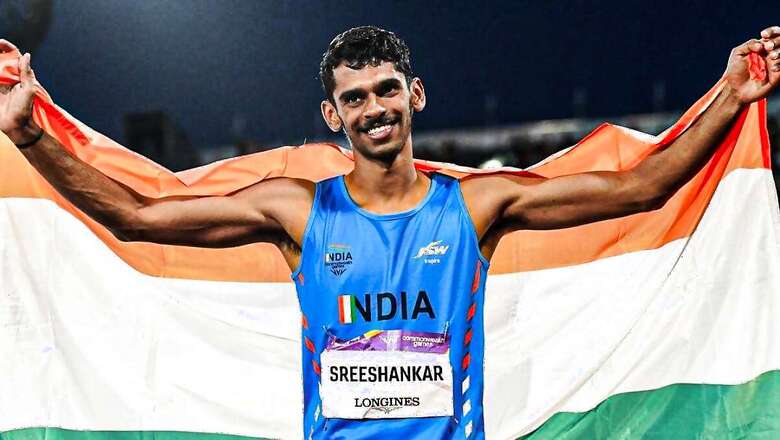
views
Long Jumper Murali Sreeshankar, one of India’s brightest gold medal prospects at the upcoming Asian Games 2023, is not leaving any stone unturned in preparation and is even skipping the prestigious Diamond League final in Eugene, USA to focus on the continental event.
In a candid conversation with News18 Sports, the 24-year-old sheds light on his preparations, the tactical decision to skip the Diamond League final, and the precise refinements he’s made to his performance techniques.
EXCERPTS FROM THE INTERVIEW:
How have you matured as an athlete and a person since the 2018 Asian Games, and how do you feel about your performances since then?
A lot of things have changed in those five years. I think I’ve matured both as an athlete and a person on and off the field also. So physically more mature, mentally more mature. And when I went to the Asian Games in 2018, I didn’t have a single eight-meter plus jump. But now when I go to the 2023 Asian Games, things are quite different. And I’ve got global stage exposure, and experience. So yes, I’m ready to fight and be in the top contenders in Asia, so the competition should be really good. And we have very good competition from the Chinese jumpers and Japanese jumpers. So yes, I think we will be able to do quite well. I and my friend, Jeswin [Aldrin], is also competing in.
Heading into the Asian Games, how confident do you feel about your current state of mind and preparation?
I’m feeling extremely confident. My preparation has been excellent, and my body is in top condition. I’m faster and more powerful than ever, and I’m in the right space mentally for the Asian Games.
You chose to skip the Diamond League final to focus on the Asian Games. Can you explain the thought process behind that decision?
To be very honest, I didn’t want to skip this event at all, but it was my dad’s decision that we skip the Diamond League finals and get ready for the Asian Games because finals are happening in Eugene from tomorrow. And long jump finals are happening on the 17th, and I just have got 12 days to prepare for the Asian Games. Preparation in the sense I have to travel from the US to China, which approximately is like a 24-hour-plus journey, and also the time difference is 15 and a half hours. So my dad, who is my coach, believes that my body will find it difficult to accommodate these sudden drastic changes and I won’t be able to recover quite well after the competition. So it will be better if we skip it and focus on the quadrennial event because the Diamond League finals happen every year and the Asian Games comes once every four years. So from an Indian perspective, Asian Games is a very big event. So we thought we’ll prioritize Asian Games over Diamond League final this season.
It was a very, very tough decision for me because it’s been one thing that has been in my mind for a very long time competing in the Diamond League Finals and getting a podium finish. And this time it could have been true because I was in a very good condition all these days. Yesterday only I told my dad, ‘If we had done the Diamond League Finals, It would have been so good.’
In terms of performance, what specific improvements have you been working on in your training routine, especially with regard to your run-up and approach?
I think one major flaw I had all these years was the technique in my approach because I was not accelerating towards the board in the last phase. So we have to work a lot on the speed on the approach. So that’s why we went to the US in the start of the season to work under my friend who works as the horizontal jumps coach at Texas Tech University. And we had an amazing training camp there for three, four weeks in Texas. And that has really helped us to get a good idea about our run-up because there were different rhythms we were confused what to use, and trying out all the rhythms and picking up the best rhythm, which I could get the best results, was the one key thing which we did in the US.
And we could finalize our approach for the entire season. And it worked out quite well. We could talk about different aspects of our run-up and work on different aspects of that. I was able to gain more speed on the approach and it really did work well and I was able to get a good competition also in California. I’ve been jumping from continent to continent, jumping. So this year has been a good experience for me.
We have often seen your performance in the final doesn’t match your qualification jumps. How do you plan to address this issue and maintain consistency in the finals?
We take the qualifying round seriously, but once we qualify, the next thing comes in our mind is push for a medal. So that’s the time when we mess up our technique a bit or give more force on the ground, try to tighten up our body and we don’t get the results as expected. The key thing is that we just stay as we stayed in the initial couple of rounds, be more free on the approach. Just don’t think about anything apart from the technique. Just execute the jump in a free-flow moment. So that will be the key thing. Even at the Commonwealth Games also, I did a qualifying jump from behind the board and in the finals I was struggling to get past the eight meters until the final round. It’s more about being more fluent and smooth on the approach. I think that would be the key for me in the Asian Games also.
You have talked about Miltiadis Tentoglou’s mental strength setting him apart from others. How important is mental strength in clutch jumps, and how do you view your own mental game in high-pressure situations?
This time, as you have seen, Tentoglou did the 8.52m jump in the last round to take the gold medal [at World Athletics Championship]. That’s the real clutch performance or clutch performer. And he has been there in circuit since a very long time. He has been competing with the top jumpers. He was just jumping eight meters or 8.10 or 7.90 like that when others were jumping 8.50. He was there since then and now he’s consistently doing some great performance. So it all comes with the experience.
Right now I’ve got very good exposure and experience on how to deal with high-level competition. Now for next year, I think it’s all about just executing it because I think myself and even Jeswin also we have got quality competitions abroad. So it will be more like just getting the execution right for the competitions. These clutch performances and performers, they are raised by the tough conditions. So Tentoglou has been there, and now I’m also passing through that phase. Hopefully by 2024, it should come out really good.
You’ve been part of a growing contingent of Indian athletes achieving success at the international level. Can you describe the camaraderie and support among Indian athletes, especially with national record holder Jeswin Aldrin?
It’s a really good friendly atmosphere that we have with Jeswin, with Praveen [Chitravel], with his team and everyone. We hang around together and we always try to push each other to improve our performances. I think for the past two years, the standards of horizontal jumps have come up quite good. We are really happy that we could contribute our part to the rise of Indian long jump and triple jump standards in fact.
We have done this at the domestic level and now it’s all about doing the same thing in the international circuits. So that comes with experience, but we always try to tell to each other that it’s definitely possible. It’s very well possible. We went to Budapest as world number one and two. So it’s about continuing the momentum, having more international exposures, having more training camps abroad, competing with the best and things will fall in place at the right time.
What are your expectations for the Indian contingent at the Asian Games, and do you believe winning 100 medals is possible this time?
With a larger contingent and improved strength, reaching a three-digit medal figure seems possible. Athletics standards have significantly improved in the past five years. The support from various sources, including the government and private sponsors, is boosting our confidence.
How has Neeraj Chopra’s success influenced you, and what role has he played in supporting fellow Indian athletes?
He has been the same person whom I met five years before and now. He’s a wonderful person to talk with, as you said, grounded and very humble person. He has been in the circuit very consistently, like the top athletes like Mondo [Armand Duplantis] or Christian Taylor in his prime. He has been in that league right now. Whenever we meet in the dinner table or for the lunch or breakfast, he used to share his experience, what are the challenges he also faced as an athlete and how he overcame that, the trainings.
And he’s a very fun person to talk with. And apart from training, he also gives a lot of insights on the places where we stay. When we were in Switzerland, he gave me a complete list of places, beautiful places where I can go on a vacation…hopefully next time. But he’s a superb person to talk with and he’s a great support for all the athletes. Whenever myself, Jeswin or Praveen compete and have a good performance, we immediately see Neeraj Bhaiya’s message in our DMs.
Neeraj Bhaiya is a very close person for us, but whenever he sends us a message, like ‘Congratulations for your great jump’, it really means a lot for us. And he always keeps track of our performance, so he keeps motivating us and he is such a gem of a person.
Can you share your experience at the Inspire Institute of Sports and the importance of such facilities for Indian athletes?
Actually, we have incredibly good facility here in Inspire Institute of Sport, one of the best. Now I’ve been around Europe, I’ve been in US, and I can fairly say that this is one of the best training facilities in the world. And fair enough to say that athletes from other countries have also expressed their interest to come and train here at with Indian jumpers, even athletes from US. So Indian standards of sport is continuously raising.
And thanks to the corporate sectors like JSW sports for having set up such incredible facilities here. The grass-root level programs have done so incredibly good. Now that we have the talent, we have a role model, we have an icon in Neeraj Chopra. So it’s time to build the infrastructure quite good so that when the young and developing athletes come, they see the facilities and they see the icons altogether.
Watch Hangzhou 2022 Asian Games from 19th September LIVE on Sony Sports Ten 2 SD & HD, Sony Sports Ten 3 SD & HD (Hindi), Sony Ten 4 SD & HD, Sony Sports Ten 5 SD & HD and SonyLIV




















Comments
0 comment